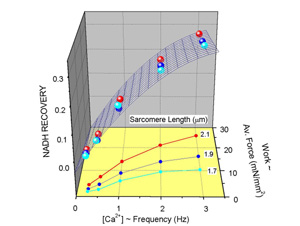Researchers study cardiac energetics with fluorescence spectroscopy
Researchers, led by Dr. Rolf Brandes at Loyola University Chicago, Illinois, are making major progress in understanding how energy production is regulated in the heart when energy consumption suddenly changes. With increased cardiac work, the production of  energy in the form of ATP (adenosine triphosphate) is precisely matched to meet the new demand of increased ATP consumption. Various control signals have been hypothesized to serve as the mechanism for this energy regulation, and Dr. Brandes is now investigating the role of some of these. The practical significance of this work is that energy deprivation under high workloads may be a factor in several heart diseases. Enlarged heart (hypertrophy) and diabetes have recently been suggested to be complicated by altered energy regulation. Understanding the fundamental processes of how cardiac energetics are regulated may therefore make it possible to more effectively treat these and other cardiovascular diseases. The basic mechanism of energy (ATP) production in the heart is accomplished by oxidative phosphorylation inside a cellular organelle called the mitochondria. The rate of oxidative phosphorylation has classically been thought to be stimulated by increased ADP (adenosine diphosphate, a possible byproduct of increased ATP consumption) because of its effects on isolated mitochondria. In an intact tissue, however, increased mechanical work does not usually correlate with increased ADP, so NADH (reduced form of nicotineamide adenine dinucleotide) has instead been postulated as the regulatory agent. (NADH also stimulates the oxidative phosphorylation rate in intact mitochondria). The basic question is whether and how increased work stimulates increased NADH in the heart. Dr. Brandes is working on the hypothesis that increased work causes increased mitochondrial calcium and thereby increases the NADH production rate (and therefore NADH concentration) by stimulating calcium sensitive enzymes (dehydrogenases).
energy in the form of ATP (adenosine triphosphate) is precisely matched to meet the new demand of increased ATP consumption. Various control signals have been hypothesized to serve as the mechanism for this energy regulation, and Dr. Brandes is now investigating the role of some of these. The practical significance of this work is that energy deprivation under high workloads may be a factor in several heart diseases. Enlarged heart (hypertrophy) and diabetes have recently been suggested to be complicated by altered energy regulation. Understanding the fundamental processes of how cardiac energetics are regulated may therefore make it possible to more effectively treat these and other cardiovascular diseases. The basic mechanism of energy (ATP) production in the heart is accomplished by oxidative phosphorylation inside a cellular organelle called the mitochondria. The rate of oxidative phosphorylation has classically been thought to be stimulated by increased ADP (adenosine diphosphate, a possible byproduct of increased ATP consumption) because of its effects on isolated mitochondria. In an intact tissue, however, increased mechanical work does not usually correlate with increased ADP, so NADH (reduced form of nicotineamide adenine dinucleotide) has instead been postulated as the regulatory agent. (NADH also stimulates the oxidative phosphorylation rate in intact mitochondria). The basic question is whether and how increased work stimulates increased NADH in the heart. Dr. Brandes is working on the hypothesis that increased work causes increased mitochondrial calcium and thereby increases the NADH production rate (and therefore NADH concentration) by stimulating calcium sensitive enzymes (dehydrogenases).
